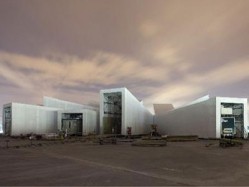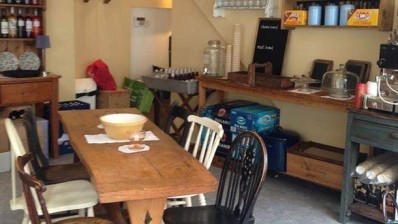How to run a pop-up restaurant

If you’re planning on running a pop-up restaurant or bar, don’t think you’re going to make a small fortune out of it – temporary operations tend not to be very lucrative, if at all. The costs and overheads associated with a temporary structure, be it for one night, one week or a month, can mount up to the point where you’re charging ridiculous sums of money for each cover.
“For us it’s more of a marketing exercise than a revenue generating exercise,” explains Lee Behan, founder of the Friday Food Club which is hosting a series of pop-up restaurants at Soho’s Meza. “The seats are selling for £68 and out of that we have to cover the costs of food, front of house and kitchen staffing, marketing, back of house and alcohol. After that we’re lucky if we come out breaking even. It’s all a PR exercise really.”
The notion of running a pop-up can also be a logistical nightmare, organising and training an often completely new team to cope with a new menu and space in a very short period of time. But if done properly, the temporary operation can return valuable exposure for your business.
Adam Fellows, owner of Goodfellows seafood restaurant in Wells, Somerset, and the operator of Glastonbury’s first pop-up fine dining restaurant in 2009, said the biggest return he saw was an uplift in business at his main restaurants.
“The one big spin off from Glastonbury was that we had a really big knock on effect from a PR point of view,” he says. “Lots of people that lived 1-2 hours away from the festival site came back to visit our main restaurants in Somerset afterwards. The PR effect is invaluable and difficult to quantify but the pop-up certainly produced a really good buzz and we did get some customers off the back of it.”
Step one: Location
If you’re intent on running a pop-up, the first thing you need to get clear is where you want to do it. You could choose to take advantage of the high footfall provided by pre-arranged festivals and events, or generate high levels of interest by hosting your pop-up within a well-known, already established restaurant or bar.
Wherever you choose, make sure you think about how your location relates to your own offer and target audience, and ensure they both complement each other. This holds true whether you decide upon an existing restaurant or bar space, a festival, a street corner, empty building or rooftop.
“All the brands we’ve chosen to work with have been carefully selected,” says Eadaoin O’Brien, hospitality manager for Harvey Nichols, which has hosted a range of pop-ups from the likes of Mahiki rum and patissier Claire Clark. “That’s the most important starting out point, that the brand you choose to work with is the most appropriate for you and your customer profile.
“Our aim is to work with a like-minded brand that our customers’ experience will be maximised.”
Also bear in mind the location’s surrounding demographic and existing operation: the last thing you’d want is to run a pop-up restaurant with 100 covers on a Saturday night in a space in London’s West End that would usually do 95 covers anyway.
“We try to look at places where the covers earlier in the week might not be as strong as later in the week, so it’s a win-win situation for both you and the owner/operator of the building you’re using,” adds Behan.
Step two: Menu
Keep it simple, especially for your first pop-up attempt anyway. You’ll be working in unfamiliar surroundings with potentially a team of front of house and kitchen staff you don’t know and who aren’t used to your menu, so trusting waiters to perfectly serve liquid nitrogen ice cream at the table could be foolish.
“If you’re popping up in a restaurant where you’ve got to use the existing kitchen brigade and all your dishes are hot and complex, you might want to rethink that to give yourself some breathing space throughout your service and menu,” says Behan.
“However you must still serve great tasting food. Ultimately the food you serve is the most important thing - it has to stand up to expectations. Make sure you know your menu inside out comfortably, and that your front of house team knows what they’re doing because they can make or break you.”
Price your menu according to what your customer can afford. If you’re popping up at a local food festival, passers-by aren’t going to be tempted by fine dining prices, no matter how incredible your offer is.
Despite his restaurants being high end operations, Fellows charged less than £10 a dish at his Glastonbury pop-up, which was in fact relatively expensive for a festival menu.
“You have to be conscious that most people will be paying in cash, and that there’s a limit to what they are willing to pay,” he says. “If you do it year on year you could build the price up but ultimately if it’s a festival people are there for the music and as much as you need to cover your costs, you have to fit within that.”
Step three: Logistics
The majority of planning for your pop-up will likely go into its design and operation. As with any new restaurant launch, think about the amount of covers you can feasibly do with your staff size, what layout will enable you to effectively turn the tables and how the space will be decorated to communicate your brand/ pop-up’s message.
On top of this you’ll also need to consider where you’ll source your kitchen equipment from, how you’re going to have your gas, electricity and water supplied (if you’re not in an existing restaurant or bar), what licenses you’ll need for the period of your pop-up, and what regulatory requirements you’ll need to meet.
License requirements can vary from council to council so it’s best to get in touch with your local authority as early as possible to ensure you have everything signed off in time for launch.
Some licences you may be required to obtain include: Late licence, alcohol licence, live music permission, fire safety and environmental health approval, licence from the owner of the land the restaurant will be located on.
Step four: Marketing
Pop-up restaurants are hardly a new concept, and with so many around, how can you entice diners to yours instead of the next big thing to hit London?
“It’s about having a story to sell and not something that’s been done a hundred times as you won’t generate any interest,” claims O’Brien, who will often choose operators with a new product to sell or business to promote.
Dehan however chose a number of high profile chefs that weren’t usually accessible to diners to help co-host his pop-up, which is run alongside Anna Hansen’s Modern Pantry at Meza this month.
However the best way to spread the word about your new pop-up is through social media, namely Twitter. Former Masterchef winner Mat Follas’ Kai We Care pop-up restaurant, held last night at One Moorgate Place, was the result of a musing on Twitter that ended up generating interest from across the hospitality industry, and over £60k for the New Zealand Earthquake relief.
“Twitter is unbelievable as a marketing tool,” exclaims Behan. “If you can create a buzz around your pop-up you’ll find the phone starts ringing almost immediately.”
All this month we’ll be looking closely at how others have successfully run pop-up restaurants and bars, starting next week with Adam Fellows’ Goodfellows Glastonbury pop-up.


























